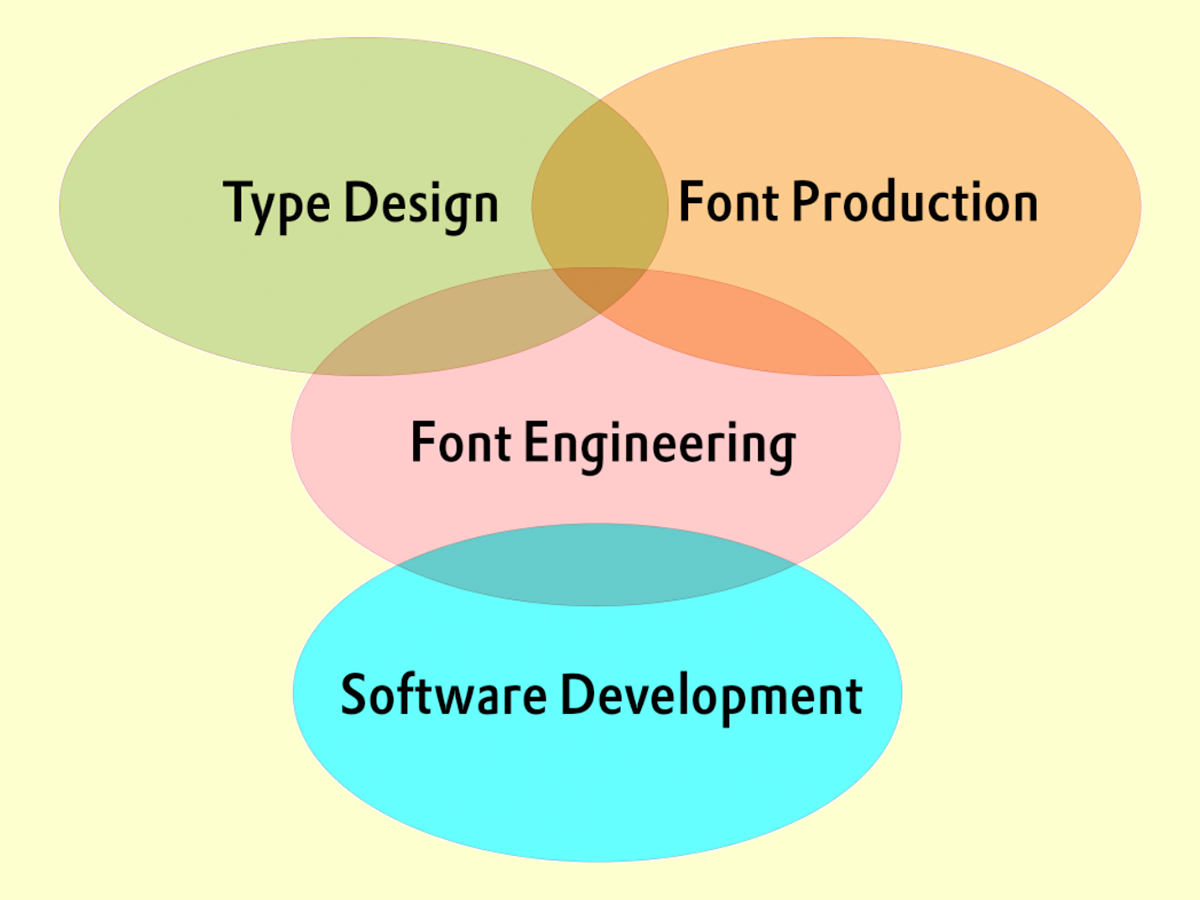Type Design vs Type Engineering?

Russell McGorman
Posts: 275
I'd say there's a spectrum with "type design" on one end and "type engineering" on the other... But where does the design part end and the engineering part begin? Obviously there's more to it than metrics and OT features...
0
Best Answers
-
The diagram below places font engineering within the broader context of font creation. It highlights areas of overlap with other key activities involved in the process. Of course, this represents a subjective perspective based on how we approach things at DTL. Others participating in this discussion may well produce a diagram that looks quite different, depending on their own experiences and focus.
 In this view, scripting and automation tasks, such as font-build systems, custom tooling, or font testing, are considered part of font engineering. That is why the diagram shows a clear overlap with software development, rather than linking software development directly to font production.4
In this view, scripting and automation tasks, such as font-build systems, custom tooling, or font testing, are considered part of font engineering. That is why the diagram shows a clear overlap with software development, rather than linking software development directly to font production.4 -
By "proper grammar" I think AI Large Language Models means a little janky?1
Answers
-
I think this is up to the type designer; some people like to do the whole process by themselves, others are only interested in the visual culture and drawing craft aspects, and are happy to leave as much technology to others. And many projects require a back-and-forth collaboration between the two activities, which can happen inside one person "with two hats", or between two+ collaborators - with Latin and NonLatin examples all around
 4
4 -
Yes, and a third role (beyond the classic two we might call (caricature?) as "artistic" and "technical") is a cultural expert or "informant" (in the ethnographic, not law enforcement sense). I speak from sometimes-painful experience since I have had to (try to) do all three roles for my Biblical Hebrew font!Dave Crossland said:[...] many projects require two+ collaborators
Within the technical role, I want to mention an area that is (AFAIK) pretty new, which is automated font testing. I feel this is notable since formerly (and still usually) we think of the technical parts of the font as internal to the font. But, for example, my font contains not only OpenType feature code internal to the font but also Python code external to the font, driving automated collision testing!4 -
But where does the design part end and the engineering part begin?I would say the division, insofar as one can be said to exist, is at the level of the specific font format, i.e. the particular technology for which a typeface design is being engineered. That is the level at which it is possible for a design to be engineered without reference to the designer, and at which the designer, upstream, does not need to be aware of the technical details of that format or, indeed, be aware of the format at all. This is demonstrated, repeatedly, by the adaptation of existing designs to new formats.
But typeface design itself is inherently technical, independent of the details of specific formats or technologies. So there is no division in which design sits on a creative side that is insulated from knowledge of or concern with technical implementation. That is especially true today, when most people who design typefaces are doing so within font editing software, even if they hand off some aspects of final production to someone else.
And, of course, the more the designer understands of the technical capabilities of a target font format, the more those capabilities can inform the design and be taken advantage of to express new creative ideas.4 -
Thank you...
I'm asking because I've been getting some work from a company to helping clients with some of the technical details such as OT features, metrics, etc. It's something I like doing, is worth the time, and is something I can do... Though, being self taught, up to a point. There are of course things I don't know that I don't know.
I'm working to expand my abilities to a level where I can in good conscience include the term "font engineer", (or an equivalent term) in services I can offer, without over-selling it. Having worked for years as a wayfinding designer in the engineering department of a commuter rail service, I've internalized the idea of an engineer as the person directly responsible for bridges not falling down. I think there has to be a minimum standard for me to meet.
4 -
I am not so sure, mostly because this is (for the most part) not a bridge-falling-down problem. But I also sympathize with your desire not to overstate your skills. That is commendable, even.
Perhaps you could call yourself a level 1 font engineer, or usomething? Not that there are established levels. But “junior font engineer” doesn’t really sound right, in the sense that there is some stuff you now pretty darn well. You know?0 -
I think there has to be a minimum standard for me to meet.There is, but it isn’t very well defined in the business, in part because of the absence of any specific educational opportunities for font engineering. If someone had gone through one of the various type design programmes, I have a pretty good idea what they know and what kind of experience they have, but there is nothing comparable in terms of a curriculum for the technical side of making fonts.
I do know that there are individuals whom I definitely think of as ‘font engineers’, and others whom I think of as ‘people who do font production’—I am in the latter category—, but I am not sure exactly where the distinction line is.
1 -
Well, that brings to mind another phrase you could use: “font production specialist.” Works for me.
1 -
I usually refer to myself as a ‘font maker’, which I guess means I think about it more like crafting furniture or shoes than building bridges.0
-
For me, the distinction is a negative one - I am a font engineer because I do everything apart from the outlines. People who draw curves are type designers (who may or may not do their own production); people who don't are engineers.John Hudson saidI do know that there are individuals whom I definitely think of as ‘font engineers’, and others whom I think of as ‘people who do font production’—I am in the latter category—, but I am not sure exactly where the distinction line is.
2 -
I think universities and institutions who are teaching type design are missing an opportunity in not starting a specialisation in font engineering. Though I don't know what will be the demand of graduates who pass out from that course.2
-
Simon, I think you are one of the people whom I consider a font engineer in part because you make a lot of your own tools. Perhaps that is the diistinction between my mental categories of font engineer and people who do font production. It’s a distinction of depth and method. I’ve done font production work for other people occasionally, so not being a type designer in that context, but I don’t consider myself an engineer.1
-
Years ago my job title was Network Engineer, and I was paid to tweak config files on Cisco routers. Most jobs are 99% mind-numbing drudgery. Back in the late 90s a certain foundry owner lamented to me that he had just learned more about postal meters than anyone ever wanted to know.0
-
I associate engineering, in the font business, with writing code.
2 -
Type design is the creative process of shaping letterforms to define the visual identity of a typeface. It involves achieving aesthetic balance and style.
In contrast, type engineering focuses on the technical side, such as creating font files (e.g. OpenType), implementing features like ligatures, and ensuring the font works across platforms.
The distinction between the two disciplines becomes blurred when designers consider technical elements early on, such as OpenType features or screen rendering, and when engineers need a solid understanding of design for proper implementation. The two disciplines are deeply intertwined throughout the process.4 -
There are also tasks often done by “font production” folks, such as diacritic positioning/attachment, which certainly have design elements/impact.0
-
The two disciplines are deeply intertwined throughout the process.If engineering is concerned with function rather than appearance, typeface design is per se also engineering, a typeface’s appearance being its function.
This conflation of aesthetics with engineering is what makes typeface design unique, except perhaps for a comparison with music composition.
We do distinguish between typeface design and font design, however.
2 -
To me, type design has more in common with industrial design than with engineering or music. Engineering is primarily about performance, optimization, and solving technical problems. Music, by contrast, is about expressive structure and emotional experience. Industrial design sits somewhere in between: it focuses on usability, manufacturability, and consistency, all of which are central to type design. Font production involves standardization and repeatability, but those are more properly the domain of font engineering.
Today, font engineering supports rather than defines type design. Those familiar with my research will know that I argue this was not always the case. In the early days of Western typography, technical constraints played a much more dominant role. They often defined the very patterns that formed the basis for harmony and rhythm in type. In that historical context, engineering and design were tightly intertwined.
The present-day type designer, however, is no longer bound by those kinds of limitations. Digital tools have dramatically reduced technical constraints, giving designers far greater freedom to prioritize visual and functional intent over mechanical feasibility. That shift contradicts the idea that type design today is a form of engineering –at least in the traditional sense of being driven by technical requirements. Instead, engineering now plays a supporting role, helping to implement and scale a design rather than determine its form.
I see where the music analogy comes from; after all, both involve rhythm, variation, and formal structure. But music typically does not serve a practical, external function. It may convey emotion or narrative (the latter especially in opera or oratorio), but that is not the same kind of practical function that type is designed to fulfill.
And really, the mix of aesthetics and function is not unique to type: it is typical of most industrial design. Take a chair: yes, it has to support weight, but how it looks and feels also affects how it is used and perceived. The same is true for type. A typeface is not just about how individual letters look, it is about how the whole system performs when put to use. Type design lives in the tension between art, engineering, and industrial systemization. It is closer to architecture or product design than to music. However, it is not just mechanical either.3 -
Does Typedrawers have a policy on posting AI generated content as an answer to a post?Typedesigner said:Type design is the creative process of shaping letterforms to define the visual identity of a typeface. It involves achieving aesthetic balance and style.
In contrast, type engineering focuses on the technical side, such as creating font files (e.g. OpenType), implementing features like ligatures, and ensuring the font works across platforms.
The distinction between the two disciplines becomes blurred when designers consider technical elements early on, such as OpenType features or screen rendering, and when engineers need a solid understanding of design for proper implementation. The two disciplines are deeply intertwined throughout the process.0 -
Never thought about this! Will discuss with @James Hultquist-Todd and @Eris Alar.Daniel Calders said:Does Typedrawers have a policy on posting AI generated content as an answer to a post?-1 -
@Daniel Calders I write all my comments myself and do not use AI. I kindly ask you to refrain from making such unfounded claims.2
-
LOL. The problem with writing “proper” grammar with long sentences is that it can easily be mistaken for AI generated text.2
Categories
- All Categories
- 46 Introductions
- 3.9K Typeface Design
- 487 Type Design Critiques
- 564 Type Design Software
- 1.1K Type Design Technique & Theory
- 656 Type Business
- 861 Font Technology
- 29 Punchcutting
- 520 Typography
- 119 Type Education
- 324 Type History
- 77 Type Resources
- 112 Lettering and Calligraphy
- 33 Lettering Critiques
- 79 Lettering Technique & Theory
- 559 Announcements
- 94 Events
- 114 Job Postings
- 170 Type Releases
- 180 Miscellaneous News
- 276 About TypeDrawers
- 54 TypeDrawers Announcements
- 120 Suggestions and Bug Reports








